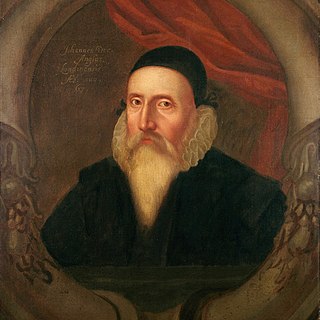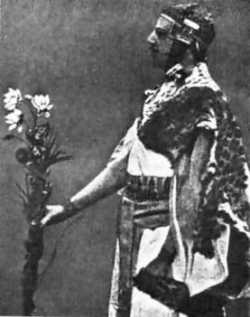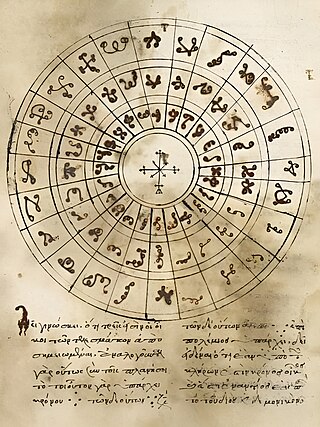
The Hermetic Order of the Golden Dawn, more commonly the Golden Dawn, was a secret society devoted to the study and practice of occult Hermeticism and metaphysics during the late 19th and early 20th centuries. Known as a magical order, the Hermetic Order of the Golden Dawn was active in Great Britain and focused its practices on theurgy and spiritual development. Many present-day concepts of ritual and magic that are at the centre of contemporary traditions, such as Wicca and Thelema, were inspired by the Golden Dawn, which became one of the largest single influences on 20th-century Western occultism.

Ceremonial magic encompasses a wide variety of rituals of magic. The works included are characterized by ceremony and numerous requisite accessories to aid the practitioner. It can be seen as an extension of ritual magic, and in most cases synonymous with it. Popularized by the Hermetic Order of the Golden Dawn, it draws on such schools of philosophical and occult thought as Hermetic Qabalah, Enochian magic, Thelema, and the magic of various grimoires. Ceremonial magic is part of Hermeticism and Western esotericism.
A pentacle is a talisman that is used in magical evocation, and is usually made of parchment, paper, cloth, or metal, upon which a magical design is drawn. Symbols may also be included, a common one being the six-point form of the Seal of Solomon.

Bael is a demon described in demonological grimoires such as The Lesser Key of Solomon and the Pseudomonarchia Daemonum and also in the Dictionnaire Infernal. He is described as a hoarsely-voiced king with the power to make men invisible and ruling over sixty-six legions of demons. The Lesser Key of Solomon describes him as appearing in the form of a cat, toad, human, some combination thereof, or other "diverse shapes", while the Pseudomonarchia Daemonum and the Dictionnaire Infernal state that he appears with the heads of a cat, toad, and human simultaneously.
The Lesser Key of Solomon, also known by its Latin title Lemegeton Clavicula Salomonis or simply the Lemegeton, is an anonymously authored grimoire on sorcery, mysticism and magic. It was compiled in the mid-17th century, mostly from materials several centuries older. It is divided into five books: the Ars Goetia, Ars Theurgia-Goetia, Ars Paulina, Ars Almadel, and Ars Notoria. It is based on the Testament of Solomon and the ring mentioned within it that he used to seal demons.
In demonology, Halphas is the thirty-eighth demon in the Ars Goetia in the Lesser Key of Solomon, ranked as an earl.
Bathin is a demon described in demonological grimoires.
Lerajie is a mighty Great Marquis of Hell who has thirty-three legions of Demons under his power. He is said to cause great battles and disputes, and makes gangrene wounds caused by arrows. He can make a lover come to him, and also send them away. He is depicted as a gallant and handsome archer clad in green, carrying a bow and quiver, in the folklore of the Bible. But his true appearance is around 5 feet tall, with shoulder length black hair and bangs. With a long shimmering red wingspan. Leraje is a demon mentioned in demonological grimoires. He appears in the Lesser Key of Solomon, Johann Weyer's Pseudomonarchia Daemonum, and Jacques Collin de Plancy's Dictionnaire Infernal.

Gemory is a demon listed in demonological grimoires.

Enochian magic is a system of Renaissance magic developed by John Dee and Edward Kelley and adopted by more modern practitioners. The origins of this esoteric tradition are rooted in documented collaborations between Dee and Kelley, encompassing the revelation of the Enochian language and script, which Dee wrote were delivered to them directly by various angels during their mystical interactions. Central to the practice is the invocation and command of various spiritual beings.

Samuel Liddell MacGregor Mathers, born Samuel Liddell Mathers, was a British occultist and member of the S.R.I.A.. He is primarily known as one of the founders of the Hermetic Order of the Golden Dawn, a ceremonial magic order of which offshoots still exist. He became so synonymous with the order that Golden Dawn scholar Israel Regardie observed in retrospect that "the Golden Dawn was MacGregor Mathers."

A lamen is a magical parchment or pendant, sometimes acting as a protective 'magical breastplate' worn around the neck so that it hangs upon the breast over the heart. Its uses vary but, most commonly, the term refers to a symbol of authority and a focus of magical energies.

The Arbatel De Magia Veterum is a Latin grimoire of Renaissance ceremonial magic published in 1575 in Switzerland.

A table of magical correspondences is a list of magical correspondences between items belonging to different categories, such as correspondences between certain deities, heavenly bodies, plants, perfumes, precious stones, etc. Such lists were compiled by 19th-century occultists like Samuel Liddell Mathers and William Wynn Westcott, who in the 1890s prepared an (unpublished) manuscript called The Book of Correspondences. This manuscript was later reworked by Aleister Crowley, who anonymously published it in 1909 as Liber 777. These tables of correspondences were meant to be used in a ceremonial context, where specific magical objects were assigned to specific deities or Kabbalistic emanations (sefirot).
In Thelema, the Abyss represents a metaphysical concept that signifies the great chasm or void separating the manifest world from its divine source. Aleister Crowley, the founder of Thelema, extensively explored and integrated this concept into his esoteric teachings, imbuing it with deep spiritual significance.

The body of light, sometimes called the 'astral body' or the 'subtle body,' is a "quasi material" aspect of the human body, being neither solely physical nor solely spiritual, posited by a number of philosophers, and elaborated on according to various esoteric, occult, and mystical teachings. Other terms used for this body include body of glory, spirit-body, luciform body, augoeides, astroeides, and celestial body.

In ceremonial magic, a magical formula or a word of power is a word that is believed to have specific supernatural effects. They are words whose meaning illustrates principles and degrees of understanding that are often difficult to relay using other forms of speech or writing. It is a concise means to communicate very abstract information through the medium of a word or phrase.

The Alpha et Omega was an occult order, initially named the Hermetic Order of the Golden Dawn, co-founded in London, England by Samuel Liddell MacGregor Mathers in 1888. The Alpha et Omega was one of four daughter organisations into which the Hermetic Order of the Golden Dawn fragmented, the others being the Stella Matutina; the Isis-Urania Temple led by A. E. Waite and others; and Aleister Crowley's A∴A∴. Following a rebellion of adepts in London and an ensuing public scandal which brought the name of the Golden Dawn into disrepute, Mathers renamed the branch of the Golden Dawn remaining loyal to his leadership to "Alpha et Omega" sometime between 1903 and 1913. "The title was usually abbreviated as A.O." and according to some sources its full name was "Rosicrucian Order of Alpha et Omega". All of the temples of the order appear to have gone out of existence by the Second World War.

The Magical Treatise of Solomon, also known as the Hygromanteia or Solomonikê, is a collection of late Byzantine-era grimoires written in medieval Greek. A pseudepigraphon, the book purports to contain Solomon's instructions to his son Rehoboam on various magical techniques and tools to summon and control different spirits and their powers, astrological beliefs, select charms, different means of divination, and the magical uses of herbs. The Magical Treatise survives in fragments from a number of manuscripts dating from the 15th century CE. The book has been important for the history of European magic, serving as a link between the earlier Greek magical practices and the later grimoires of Western Europe. During the early modern period, the book begun to be translated in Latin, becoming the source for future European grimoires, most notably the Key of Solomon.
A magical alphabet, or magickal alphabet, is a set of letters used primarily in occult magical practices and other esoteric traditions. These alphabets serve various purposes, including conducting rituals, creating amulets or talismans, casting spells, and invoking spiritual entities. Several magical alphabets, including the Celestial Alphabet, Malachim, and Transitus Fluvii, are based on the Hebrew alphabet, which itself has a long history of use in mystical and magical contexts.












